1959 was a year of change for Studebaker-Packard Corp. First, the storied Packard brand – which had been around since 1899 — was gone. And second, the new Studebaker Lark compact was born. It would be the sales shot in the arm that the company needed, but that success would prove short-lived. The following year, Detroit got into the compact car game big-time. A true survivor from the last years of Studebaker is this stunning 1963 Lark Cruiser which looks like it was just released from a time capsule. This remarkable automobile is located in Hayward, California and available here on craigslist for $17,500. You can always count on Barn Finds reader Ikey Heyman to find the cool cars for us!
The Lark would not be the first entrant into the American compact car segment (Rambler got there first in 1958 with the American), but it would help light the fire that eventually saw GM, Ford and Chrysler react. From 1959 until the end of Studebaker in 1966, the Lark and its variants it would be the best- selling car the company would build. The auto wasn’t all new, having been designed around the core bodyshell of the full-size 1953–58 Studebakers. Even with its smaller dimensions, the Lark could seat six people comfortably and had a decent amount of trunk space.
By the time the second generation of the Lark came around (1962-1963), sales were falling due to all the new competition. As such, the Lark received a bit a facelift that was both tasteful in appearance and economical to execute. Studebaker had always tried to get one step of the others and did so again by offering front disc brakes as an option on the Lark for about $100 extra (there is no reference as to whether the seller’s car has them). 1963 was also the first year of the iconic Avanti, but the news of that car didn’t do much to help Studebaker overall and Lark sales declined again to 77,000 units.
The seller’s 1963 Lark looks like an almost new 57-year-old car. It’s the Cruiser edition, the luxury version of the Lark which actually minimizes Lark script on the car to reduce the perception of an econobox. We’re told this particular car was previously owned by the president of the Studebaker Club (we assume Studebaker Drivers Club). The mileage is said to be documented at just under 11,000, which means someone decided early-on to preserve this car, three years before it would cease production.
It truly is a beautiful machine, although the seller omits including any photos of the trunk, engine compartment, or undercarriage to completely validate its originality. The body looks rust-free, the paint shiny and the glass sparkling. For a smaller car, it sure has a lot of guards to protect the polished chrome bumpers! The interior is equally impressive, with the plush fabric on the seats reminding me of the yards and yards of it you’d see in the interior of a 1980s Cadillac.
The seller’s Lark Cruiser has the 289 Studebaker V-8 (2-barrel version we presume) with an automatic transmission, giving it ample muscle to power this machine. Hagerty suggests top dollar for a 1963 Lark to be $15-16,000, but considering that this is the high-line Cruiser, has such low miles and is in such incredible condition, the asking price sounds more than reasonable. This would be a beautiful piece of automotive history to own without going broke in the process.





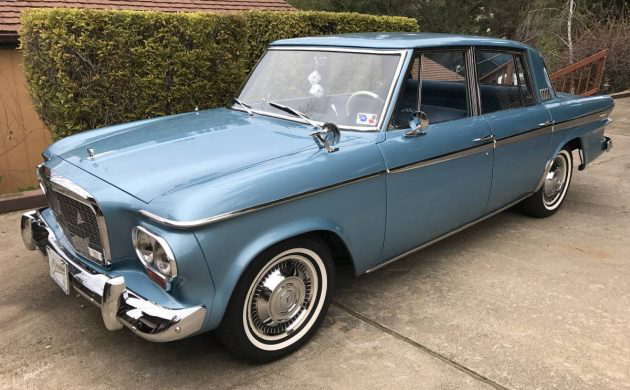
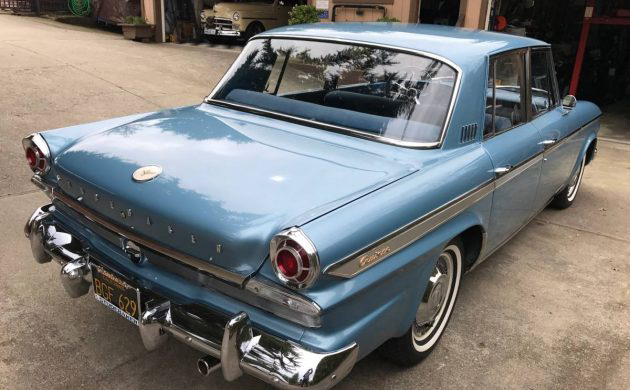
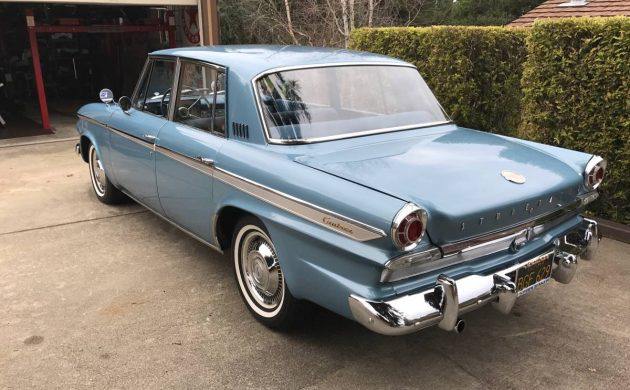

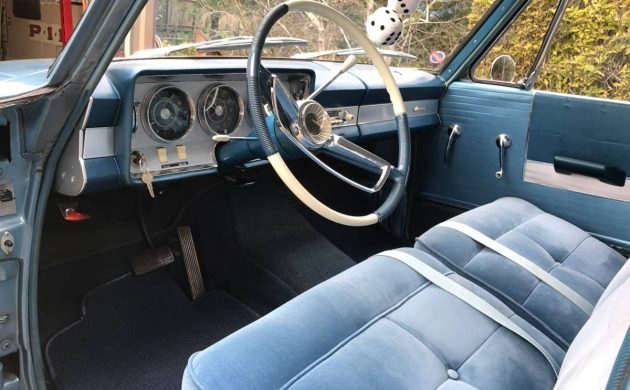
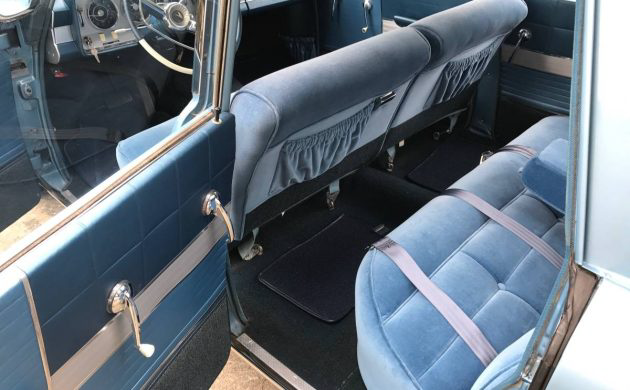

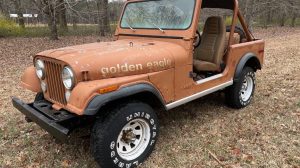
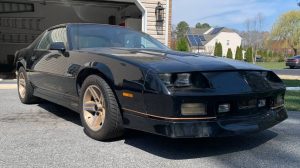
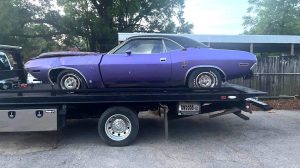


“Wiiiilber, hello,,,I’m Mr. Ed”,( who, are you sitting down, was actually a female),,that show, probably THE most popular show on TV at the time, helped sell a lot of Studebakers. Wilbur drove a blue ’63 Lark like this. Didn’t help, though, the show went off the air in 1966, and so did Studebaker. Say what you might, coming from Wisconsin, and being a devout Rambler fan, we always kind of had sympathy for Studebaker. And vice versa. Saw lots of Ramblers in Indiana, and Studebakers in Wisconsin. They, like us, weren’t part of the Big 3. Coming from small towns, our friends and neighbors built these. Too bad the end was near, it was a fantastic car. Look at it, Studebaker had some great people working for them. It had features the Big 3 took years to adapt. This car, by all rights, should have been huge, and for a small group, it was, but Studebaker just plumb ran out of steam, and even a genius like Brooks Stevens, who had a radical plan for the “new” Lark, couldn’t save it.
https://www.indieauto.org/2020/02/01/1965-studebaker-lark-concept-almost-a-baby-lincoln/
First car was a ’59 Lark sedan, flathead six with 3 on the tree.
Running and driving car for which I paid 2% of the asking price on this one.
What a beauty. And with a 289 V8. Worth every penny.
Actually, Nash got to the American compact car segment in 1950 with the Nash Rambler – that’s what the ’58 American is, with a few tweaks. :)
Great-looking Lark though I always liked the 1964 restyle the best.
Studebaker in the 1930’s did a good job of doing away with Pierce and in the 1950’s it was Packard and finally they did themselves in.
Packard contributed to their own end by holding onto the 1951 design with almost zero changes for four model years (unusual in that class in that time period), not having a V8 until 1955, and having quality issues with ’55 and ’56 cars, which were built in a cramped, leased plant on Conner Ave. in Detroit. Per Business Week, although Studebaker’s sales were down 33% from 1955, Packards were down, quote, “a thumping 67%”. Studebaker had its best profit year in history in 1959.
thnx 4 da link Howard. I C the ambassador and merc grill in that (similar to 8th pic down in link). Same art deco small squares, the fold-in-the-middle but inward, etc. (Luv the Merc, a “Calente`, even more due to combining w/the stacked hdlghts).
Might be the same in music “Nothing ever new, we just up the tempo or bring in the horns instead.”? Also love the early 60s as the bulge-mobiles of the 50s are gone and the ‘hump over the wheels’ of the later 60s have not shown up yet. Course my very fav are the mid 30s (usa) – the round sensual euroeans of the 50s/early 60s (Italian, some Brits too).
Whenever a 60’s Studebaker pops up here, there’s usually a certain amount of “shoulda coulda woulda” as well. I always wonder what would have happened if the proposed merger of Hudson, Nash, Packard, and Studebaker had gone through – would any of them be here today?
The independents might have stood a chance if they had merged together like Nash’s George Mason wanted to do after the war while still financially healthy.
Unfortunately they waited until the wolf was at the door and particularly as Packard found out, merging their ailing company with an already flat broke Studebaker was not the path to riches. (AMC had a bit better time of it since Nash was still in fairly good shape, it was Hudson that was in dire straits.)
I have wondered what a Nash, Hudson, Packard would have done. Studebaker was beyond hope.
Funny, Studebaker outlived Packard, Nash, and Hudson.
The Nash and Hudson nameplates were retired after ’57, but the combined companies as AMC of course outlived Studebaker by a couple of decades.
Neither company went out of business. Studebaker invested their Lark profits into diversification and decided they could make more money by closing down the automotive division. As we all know AMC was absorbed by Chrysler which wanted Jeep and the then-new Bramalea factory.
I have soft spot for Studebakers my Dad owned 65 Cruiser with bermuda brown paint work and twin stainless exhaust system although the Australian climate wasn’t kind to this colour ended up white, I love this car almost tempted to put my 70 C10 on the market for this one if only it was a 64 or 5
Well there is one still AMC morphed into Fiat/Chrysler and isn’t there a connection to AM General military vehicles?
A lot of people today have either forgotten or never realized that the “AM” in “AM General” originally stood for American Motors!
Back in the day, we all knew what AM stood for.
It’s the current generation that doesn’t know jack sh_t.
Fairly rare car, but not real desirable to many. Someone will love it, but i think the price is quite aggressive.
I predict it will sell. I sold my ’63 Lark Daytona Hardtop with R1 and Skytop, but with 103K miles and not in nearly as nice condition, for $15K ten years ago.
Welp, I never had any of the cars mentioned. Larks were to be avoided like the plague when I was in H.S. Why did the back end look like the front end?
While the Nash’s, Hudson’s, Kaisers, Ramblers and even the Tucker’s had innovative mechanical attributes, they all lacked one thing: Style.
There is this one thing to be remembered in designing a car. It MUST be designed with simple fluid lines that provoke the feminine shape. That, my friends is what sells cars! After that, the male muscle mind comes into play! Style and Grace with a whole lotta get-up.
Seems to me that they would not have been avoided like the plague among the younger set.
If I remember correctly, Studebakers of the day offered a reclining front seat option that, when adjusted properly would lay flat with the rear seat.
Just a few strategically placed pillows would have upped my game in high school considerably!
The bed on wheels was famous for the 4 door/wagon Rambler.
Back in the early 60s, it was a standing joke.
Especially to the drive-in movie set.
Jcs,
While I respect your point of view, it seems that no Homecoming Queen would dare be seen in a Lark. In my day, Corvettes and muscle cars absolutely reigned supreme! I agree with you that pillows were ALWAYS good to have in any back seat! Again, the car makes I mentioned had innovation, just lacked invitation. !!
The independents had all the style, the big three has layers of chrome, nothing else.
Its a shame there are no pictures of engine compartment and undercarriage. I don’t get it. It’s such a nice car. It certainly leaves a question mark as to the authenticity of the car or the seller’s decision in omitting it. Beautiful car.
Your right about the ’80s interior fabric. Someone went to great lengths to reupholster this Cruiser with a well fitting, comfortable material, yet Studebaker nor any other manufacturer offered anything like this back in the day.
Wrong-o. That is indeed the 1963 optional Cruiser broadcloth upholstery and pattern.
Well worth the bucks. A beautiful car. Studes were just a car back in the ’60’s but take this baby to a car show now and see which ride gets the attention.
I bought a 1960 Lark 4 door sedan with the small V8 and a standard with overdrive transmission in 1961 and that was a poorly made car we were
glad to get rid of.I got a demo ride in an Avanti and it was impressive but a corporate hot rod wasn’t in our plans.Later I found out it was a last gasp effort to save a failed company from the coming collapse.
Packard had sales of a dismal 27000 cars in 1954 and the quality control or lack thereof in the 1955’s helped nothing.The Ultramatic was a big problem
and I saw nearly new cars with the transmissions out on the floor of the dealers shops,The 1956 was better but too little too late and they were good looking cars that few wanted,I had a 1955 Patrician and had 3 transmissions in it and none of them held up.A sad finale for a once proud maker.
I think 90% of comments, today, were attributed to this Lark.
Good news is, I think I can now build my own Lark, from scratch. LOL!
A buddy of mine had a ’54 Packard convertible. What a tank. Fun ride.
True Studebaker helped kill of both both Pierce-Arrow and Packard except with Pierce, Studebaker was in control, and with Packard, Packard was in control – at first. Until Curtis-Wright came in and assumed Studebaker was the “big producer’, so eliminate the great Packard brand. In hindsight, CW knew nothing about the car business, ad shouldn’t have made those decisions. BUT, Studebaker didn’t kill off Mercedes-Benz, it’s selling partner, quite the reverse. MB sScked up all the Studebaker-Packard dealerships, blocked a revived ’59 Packard. I can’t look at a MB to this day without revulsion. This Cruiser is a beauty, I’d buy it without thinking twice. But, what’s with that second, British looking mirror? THAT would have to go!